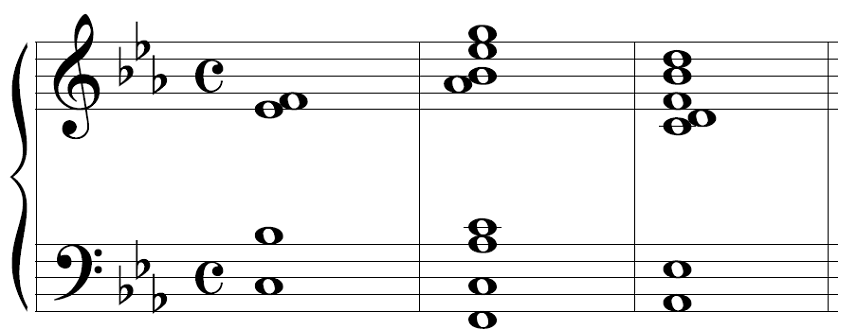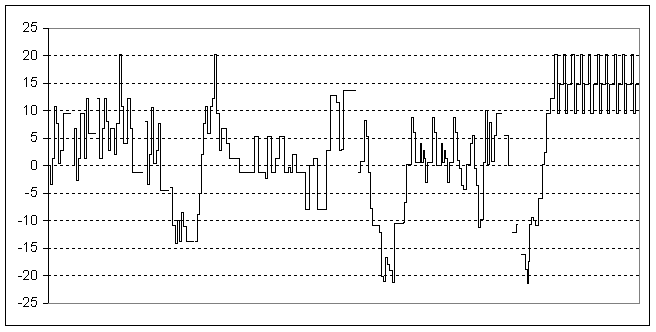
This is a capella choir music. I have not made any effort to approach the beauty of human voices in the organ sound synthesis.
The analyses below are based on the whole piece, not just the excerpt.
| F | C | G | D | A | E | B | ||||
| A♭ | E♭ | B♭ | F | C | G | D | E | |||
| D♭ | A♭ | E♭ | B♭ | F | C | G | ||||
| A♭ | E♭ |
You can download zipped .csv files containing the exact intervals used in this piece. Explanation of column headers.
An important reason to include the piece is the heavy dissonance of many of its chords. Three of them deserve special attention:

The first of these chords (not in the excerpt) occurs where the lyrics are com(ing soon). In (tempered) just intonation the chord can be rendered with four different footprints: (Check the matrix.)
(see also Matrix Video)
The extreme notes in each footprint form an interval with a non ideal pitch ratio. If the extreme notes are in the same row, e.g. C - E♭ in the first footprint, it is a minor third with a pitch ratio of 32/27 instead of the ideal value of 6/5. If the extreme notes are in different rows, e.g. E♭ - B♭ in the second footprint, it is a 'perfect' fifth with a pitch ratio of 40/27 instead of the ideal value of 3/2.
I prefer the first version, which therefore makes it to the whole piece.
The second chord that deserves special attention occurs on the lyrics (surrender) unto sleep. The chord can be rendered with four different footprints:
I prefer the third version, which therefore makes it to the whole piece.
The third chord that deserves special attention occurs right before the final fade out of the piece. The chord can be rendered with four different footprints:
I prefer the second version, which therefore makes it to the whole piece.
Still, the preferred chords have observable beating. A trick to mask that is to apply a chorus effect. Here are the three preferred chord versions with chorus effect and reverb:
My personal choices for the best footprints could be automated with the following rule: Choose the footprint with the fewest 40/27 or 32/27 intervals. Break a tie by choosing the footprint with the fewest 40/27 intervals.
But likely the actual arrangement of the tones within the chord may play a role in my preferences. That is: which of the chord tones is in the bass, soprano, etc.? How wide are the intervals between the different voices? And maybe it even depends on the loudness and the tone color of the various voices.
Anyway, if a chorus effect and reverberation can soothen beating, even of a 40/27 perfect fifth, the inevitable question is: can those effects (chorus and reverb) neutralise the beating of twelve tone equal temperament to the point that just intonation is obsolete? Here is the answer:
(excerpt, 12 tone equal temperament)
Why do the chords - in just intonation - need non ideal perfect fifths (pitch ratio 40/27) in the first place? Indeed, we could have created a series of perfect fifths all with pitch ratio 3/2. But then the major thirds in a chord would have pitch ratios 81/64 instead of the ideal value of 5/4. In my approach harmonic major thirds are always kept at pitch ratio 5/4.
If you want to analyse the chords, you can proceed as follows:
Although there is - by force - no global drift, the piece still moves back and forth through the matrix above during playing. The graph below illustrates that, as explained here.
